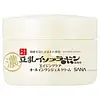What's inside
What's inside
 Key Ingredients
Key Ingredients

No key ingredients
 Benefits
Benefits

 Concerns
Concerns

No concerns
 Ingredients Side-by-side
Ingredients Side-by-side

Water
Skin ConditioningGlycerin
HumectantButylene Glycol
HumectantHydrogenated Polydecene
EmollientCaprylyl Methicone
Skin ConditioningBetaine
Humectant1,2-Hexanediol
Skin ConditioningGlycereth-26
HumectantCentella Asiatica Extract
CleansingBeta-Glucan
Skin ConditioningAcrylates/C10-30 Alkyl Acrylate Crosspolymer
Emulsion StabilisingDipotassium Glycyrrhizate
HumectantPvm/Ma Copolymer
Emulsion StabilisingGlyceryl Acrylate/Acrylic Acid Copolymer
HumectantCaprylyl Glycol
EmollientArginine
MaskingXanthan Gum
EmulsifyingHydroxyethyl Acrylate/Sodium Acryloyldimethyl Taurate Copolymer
Emulsion StabilisingEthylhexylglycerin
Skin ConditioningDisodium EDTA
Water, Glycerin, Butylene Glycol, Hydrogenated Polydecene, Caprylyl Methicone, Betaine, 1,2-Hexanediol, Glycereth-26, Centella Asiatica Extract, Beta-Glucan, Acrylates/C10-30 Alkyl Acrylate Crosspolymer, Dipotassium Glycyrrhizate, Pvm/Ma Copolymer, Glyceryl Acrylate/Acrylic Acid Copolymer, Caprylyl Glycol, Arginine, Xanthan Gum, Hydroxyethyl Acrylate/Sodium Acryloyldimethyl Taurate Copolymer, Ethylhexylglycerin, Disodium EDTA
Water
Skin ConditioningGlycerin
HumectantButylene Glycol
HumectantAlcohol Denat.
AntimicrobialCyclopentasiloxane
EmollientCetyl Ethylhexanoate
EmollientHydrogenated Castor Oil Stearate
Skin ConditioningMilk Ferment
Skin ConditioningGlycine Max Seed Extract
Skin ConditioningSoy Protein Phthalate
EmollientRetinol
Skin ConditioningSoy Isoflavones
Skin ConditioningRetinyl Palmitate
Skin ConditioningCeramide Ng
Skin ConditioningVinyl Dimethicone/Methicone Silsesquioxane Crosspolymer
PEG-40 Hydrogenated Castor Oil
EmulsifyingPEG-60 Hydrogenated Castor Oil
EmulsifyingSodium Ascorbate
AntioxidantArginine
MaskingCarbomer
Emulsion StabilisingGlycyrrhiza Glabra Root Extract
BleachingDimethiconol
EmollientSqualane
EmollientStearic Acid
CleansingGlyceryl Stearate
EmollientSodium Stearoyl Glutamate
CleansingCetearyl Alcohol
EmollientPhytosterols
Skin ConditioningTocopherol
AntioxidantCaprylic/Capric Triglyceride
MaskingSodium Polyacrylate
AbsorbentPolysorbate 80
EmulsifyingLecithin
EmollientPotassium Hydroxide
BufferingHydrogenated Lecithin
EmulsifyingPhenoxyethanol
PreservativeWater, Glycerin, Butylene Glycol, Alcohol Denat., Cyclopentasiloxane, Cetyl Ethylhexanoate, Hydrogenated Castor Oil Stearate, Milk Ferment, Glycine Max Seed Extract, Soy Protein Phthalate, Retinol, Soy Isoflavones, Retinyl Palmitate, Ceramide Ng, Vinyl Dimethicone/Methicone Silsesquioxane Crosspolymer, PEG-40 Hydrogenated Castor Oil, PEG-60 Hydrogenated Castor Oil, Sodium Ascorbate, Arginine, Carbomer, Glycyrrhiza Glabra Root Extract, Dimethiconol, Squalane, Stearic Acid, Glyceryl Stearate, Sodium Stearoyl Glutamate, Cetearyl Alcohol, Phytosterols, Tocopherol, Caprylic/Capric Triglyceride, Sodium Polyacrylate, Polysorbate 80, Lecithin, Potassium Hydroxide, Hydrogenated Lecithin, Phenoxyethanol
 Reviews
Reviews

Ingredients Explained
These ingredients are found in both products.
Ingredients higher up in an ingredient list are typically present in a larger amount.
Arginine is an amino acid that is important for human development. Your body uses is it to produce hair keratin and skin collagen.
As a cosmetic ingredient, Arginine has antioxidant properties and can also help repair damaged skin. This ingredient is derived either synthetically or from animals.
Arginine isn't fungal acne safe when used in the presence of other lipids (fats, fatty acids, oils, esters, etc). Oils and fats occur naturally within the skin, so take caution when using Arginine if you're prone to fungal acne.
Learn more about ArginineButylene Glycol (or BG) is used within cosmetic products for a few different reasons:
Overall, Butylene Glycol is a safe and well-rounded ingredient that works well with other ingredients.
Though this ingredient works well with most skin types, some people with sensitive skin may experience a reaction such as allergic rashes, closed comedones, or itchiness.
Learn more about Butylene GlycolGlycerin is already naturally found in your skin. It helps moisturize and protect your skin.
A study from 2016 found glycerin to be more effective as a humectant than AHAs and hyaluronic acid.
As a humectant, it helps the skin stay hydrated by pulling moisture to your skin. The low molecular weight of glycerin allows it to pull moisture into the deeper layers of your skin.
Hydrated skin improves your skin barrier; Your skin barrier helps protect against irritants and bacteria.
Glycerin has also been found to have antimicrobial and antiviral properties. Due to these properties, glycerin is often used in wound and burn treatments.
In cosmetics, glycerin is usually derived from plants such as soybean or palm. However, it can also be sourced from animals, such as tallow or animal fat.
This ingredient is organic, colorless, odorless, and non-toxic.
Glycerin is the name for this ingredient in American English. British English uses Glycerol/Glycerine.
Learn more about GlycerinWater. It's the most common cosmetic ingredient of all. You'll usually see it at the top of ingredient lists, meaning that it makes up the largest part of the product.
So why is it so popular? Water most often acts as a solvent - this means that it helps dissolve other ingredients into the formulation.
You'll also recognize water as that liquid we all need to stay alive. If you see this, drink a glass of water. Stay hydrated!
Learn more about Water